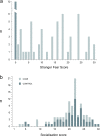A novel genomic region on chromosome 11 associated with fearfulness in dogs
- PMID: 32467585
- PMCID: PMC7256038
- DOI: 10.1038/s41398-020-0849-z
A novel genomic region on chromosome 11 associated with fearfulness in dogs
Abstract
The complex phenotypic and genetic nature of anxieties hampers progress in unravelling their molecular etiologies. Dogs present extensive natural variation in fear and anxiety behaviour and could advance the understanding of the molecular background of behaviour due to their unique breeding history and genetic architecture. As dogs live as part of human families under constant care and monitoring, information from their behaviour and experiences are easily available. Here we have studied the genetic background of fearfulness in the Great Dane breed. Dogs were scored and categorised into cases and controls based on the results of the validated owner-completed behavioural survey. A genome-wide association study in a cohort of 124 dogs with and without socialisation as a covariate revealed a genome-wide significant locus on chromosome 11. Whole exome sequencing and whole genome sequencing revealed extensive regions of opposite homozygosity in the same locus on chromosome 11 between the cases and controls with interesting neuronal candidate genes such as MAPK9/JNK2, a known hippocampal regulator of anxiety. Further characterisation of the identified locus will pave the way for molecular understanding of fear in dogs and may provide a natural animal model for human anxieties.
Conflict of interest statement
The authors declare that they have no conflict of interest.
Figures



References
-
- Carleton RN. Fear of the unknown: one fear to rule them all? J. Anxiety Disord. 2016;41:5–21. - PubMed
-
- Erhardt A, Spoormaker VI. Translational approaches to anxiety: focus on genetics, fear extinction and brain imaging. Curr. Psychiatry Rep. 2013;15:417. - PubMed
-
- Domschke K, Deckert J. Genetics of anxiety disorders—status quo and quo vadis. Curr. Pharm. Des. 2012;18:5691–5698. - PubMed
Publication types
MeSH terms
LinkOut - more resources
Full Text Sources
Research Materials
Miscellaneous

